Allosteric regulation - Study guides, Class notes & Summaries
Looking for the best study guides, study notes and summaries about Allosteric regulation? On this page you'll find 335 study documents about Allosteric regulation.
Page 4 out of 335 results
Sort by
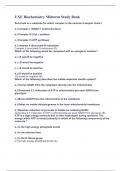
-
UNE Biochemistry Midterm Study Bank
- Exam (elaborations) • 20 pages • 2024
-
- $11.99
- + learn more
UNE Biochemistry Midterm Study Bank Succinate is a substrate for which complex in the electron transport chain? a.) Complex 1 (NADH-1 oxidoreductase) b.) Complex IV (Cyt c oxidase) c.) Complex V (ATP synthase) d.) complex II (Succinate-Q reductase) Complex II (succinate-Q reductase) (D) Which of the following would be consistent with an exergonic reaction? a.) ∆S would be negative b.) ∆G would be negative c.) ∆S would be positive d.)∆G would be positive ∆G...

-
UNE Biochemistry Midterm Study Bank Questions With Actual Solutions.
- Exam (elaborations) • 20 pages • 2024
-
- $10.99
- + learn more
UNE Biochemistry Midterm Study Bank Questions With Actual Solutions. Succinate is a substrate for which complex in the electron transport chain? a.) Complex 1 (NADH-1 oxidoreductase) b.) Complex IV (Cyt c oxidase) c.) Complex V (ATP synthase) d.) complex II (Succinate-Q reductase) Complex II (succinate-Q reductase) (D) Which of the following would be consistent with an exergonic reaction? a.) ∆S would be negative b.) ∆G would be negative c.) ∆S would be positive ...

-
UNE Biochemistry Midterm Study Bank
- Exam (elaborations) • 20 pages • 2024
-
- $13.49
- + learn more
UNE Biochemistry Midterm Study Bank Succinate is a substrate for which complex in the electron transport chain? a.) Complex 1 (NADH-1 oxidoreductase) b.) Complex IV (Cyt c oxidase) c.) Complex V (ATP synthase) d.) complex II (Succinate-Q reductase) Complex II (succinate-Q reductase) (D) Which of the following would be consistent with an exergonic reaction? a.) ∆S would be negative b.) ∆G would be negative c.) ∆S would be positive d.)∆G would be positive ∆G...
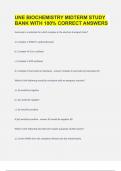
-
UNE BIOCHEMISTRY MIDTERM STUDY BANK WITH 100% CORRECT ANSWERS
- Exam (elaborations) • 32 pages • 2023
-
Available in package deal
-
- $18.49
- + learn more
Succinate is a substrate for which complex in the electron transport chain? a.) Complex 1 (NADH-1 oxidoreductase) b.) Complex IV (Cyt c oxidase) c.) Complex V (ATP synthase) d.) complex II (Succinate-Q reductase) Complex II (succinate-Q reductase) (D) Which of the following would be consistent with an exergonic reaction? a.) ∆S would be negative b.) ∆G would be negative c.) ∆S would be positive d.)∆G would be positive ∆G would be negative (B) Whi...
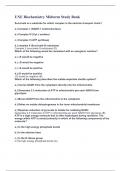
-
UNE Biochemistry Midterm Study Bank
- Exam (elaborations) • 20 pages • 2024
-
- $15.49
- + learn more
UNE Biochemistry Midterm Study Bank Succinate is a substrate for which complex in the electron transport chain? a.) Complex 1 (NADH-1 oxidoreductase) b.) Complex IV (Cyt c oxidase) c.) Complex V (ATP synthase) d.) complex II (Succinate-Q reductase) Complex II (succinate-Q reductase) (D) Which of the following would be consistent with an exergonic reaction? a.) ∆S would be negative b.) ∆G would be negative c.) ∆S would be positive d.)∆G would be positive ∆G...
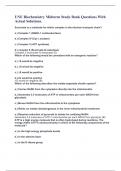
-
UNE Biochemistry Midterm Study Bank Questions With Actual Solutions.
- Exam (elaborations) • 20 pages • 2024
-
- $17.49
- + learn more
UNE Biochemistry Midterm Study Bank Questions With Actual Solutions. Succinate is a substrate for which complex in the electron transport chain? a.) Complex 1 (NADH-1 oxidoreductase) b.) Complex IV (Cyt c oxidase) c.) Complex V (ATP synthase) d.) complex II (Succinate-Q reductase) Complex II (succinate-Q reductase) (D) Which of the following would be consistent with an exergonic reaction? a.) ∆S would be negative b.) ∆G would be negative c.) ∆S would be positive ...
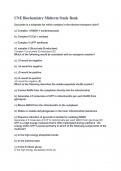
-
UNE Biochemistry Midterm Study Bank
- Exam (elaborations) • 20 pages • 2024
-
- $10.49
- + learn more
UNE Biochemistry Midterm Study Bank Succinate is a substrate for which complex in the electron transport chain? a.) Complex 1 (NADH-1 oxidoreductase) b.) Complex IV (Cyt c oxidase) c.) Complex V (ATP synthase) d.) complex II (Succinate-Q reductase) Complex II (succinate-Q reductase) (D) Which of the following would be consistent with an exergonic reaction? a.) ∆S would be negative b.) ∆G would be negative c.) ∆S would be positive d.)∆G would be positive ∆G...
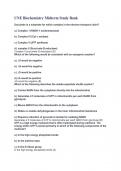
-
UNE Biochemistry Midterm Study Bank
- Exam (elaborations) • 20 pages • 2024
-
- $12.49
- + learn more
UNE Biochemistry Midterm Study Bank Succinate is a substrate for which complex in the electron transport chain? a.) Complex 1 (NADH-1 oxidoreductase) b.) Complex IV (Cyt c oxidase) c.) Complex V (ATP synthase) d.) complex II (Succinate-Q reductase) Complex II (succinate-Q reductase) (D) Which of the following would be consistent with an exergonic reaction? a.) ∆S would be negative b.) ∆G would be negative c.) ∆S would be positive d.)∆G would be positive ∆G...
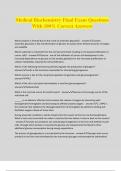
-
Medical Biochemistry Final Exam Questions With 100% Correct Answers
- Exam (elaborations) • 13 pages • 2024
-
- $12.49
- + learn more
Medical Biochemistry Final Exam Questions With 100% Correct Answers Which product is formed due to the result of anaerobic glycolysis? - answerLactate - anaerobic glycolysis is the transformation of glucose to lactate when limited amounts of oxygen are available Which substrate is extracted from the microenvironment resulting in increased proliferation of cancer cells? - answerGlucose - one of the hallmarks of cancer cell development is the increased dependence on glucose to fuel aerobic ...
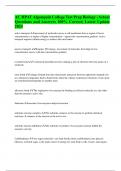
-
AC HPAT Algonquin College Test Prep Biology | Actual Questions and Answers 100% Correct| Latest Update 2024
- Exam (elaborations) • 4 pages • 2024
-
- $7.99
- + learn more
active transport movement of molecules across a cell membrane from a region of lower concentration to a region of higher concentration—against the concentration gradient. Active transport requires cellular energy to achieve this movement. passive transport Requires NO energy, movement of molecules from high to low concentration, moves with the concentration gradient covalent bond A chemical bond that involves sharing a pair of electrons between atoms in a molecule ionic bond Linkage for...

That summary you just bought made someone very happy. Also get paid weekly? Sell your study resources on Stuvia! Discover all about earning on Stuvia


